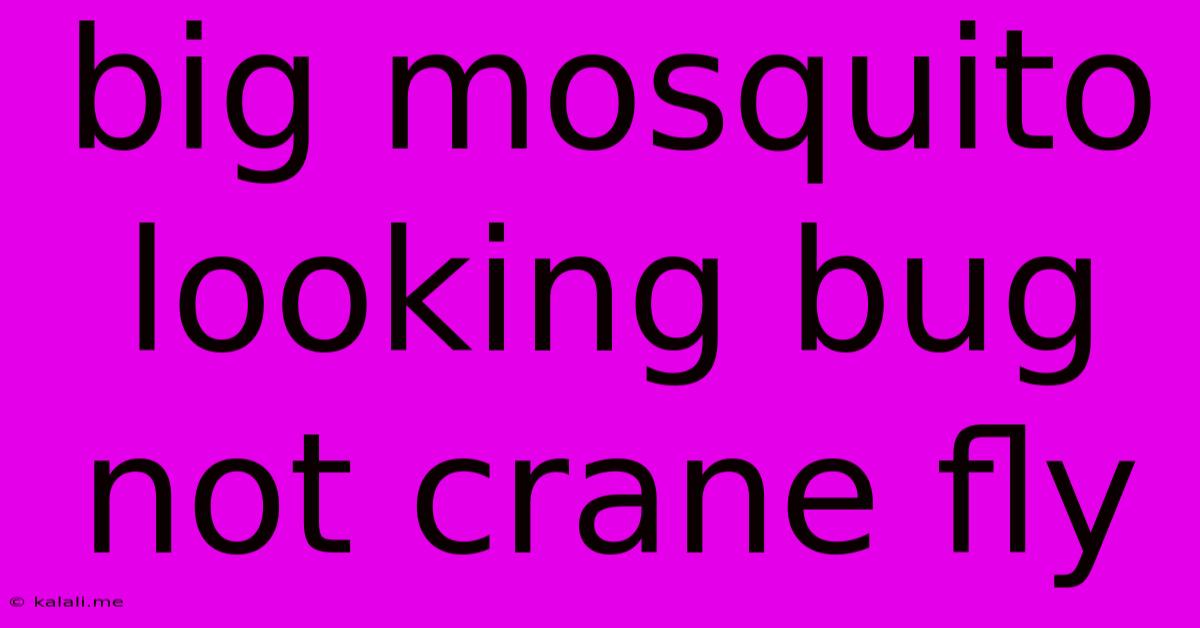Big Mosquito Looking Bug Not Crane Fly
Kalali
Jun 05, 2025 · 3 min read

Table of Contents
That Big Mosquito-Looking Bug: Identifying the Mystery Insect (and Dispelling Crane Fly Confusion)
Are you plagued by large, mosquito-like insects that aren't crane flies? You're not alone! Many people mistake various insects for crane flies, leading to confusion and unanswered questions. This article will help you identify potential culprits and learn how to distinguish them from the often-misidentified crane fly. We'll cover key characteristics and provide information to help you accurately pinpoint the identity of that giant mosquito-looking bug buzzing around your home.
Why the Confusion with Crane Flies?
Crane flies (family Tipulidae) are long-legged, delicate insects often mistaken for giant mosquitoes. However, they are harmless and don't bite. Their long legs are often the first feature that springs to mind when people describe "big mosquito-looking bugs." This resemblance is the root of much of the misidentification. But many other insects share similar physical characteristics.
Common Culprits: Big Bugs That Look Like Mosquitoes (But Aren't Crane Flies)
Several insect families could be responsible for your "giant mosquito" sightings. Here are some possibilities:
-
Larger Mosquito Species: While most mosquitoes are small, some species are noticeably larger than others. These might be mistaken for crane flies, especially at a distance. The key difference? Mosquitoes possess a proboscis (a long, needle-like mouthpart) for feeding on blood.
-
Gall Midges (Family Cecidomyiidae): Certain gall midge species can be quite large and resemble mosquitoes. These insects are usually less slender than crane flies and might exhibit different wing venation patterns.
-
Other Dipterans: The order Diptera encompasses flies and mosquitoes, and many families contain species that could be mistakenly identified as large mosquitoes. Careful observation of wing structure, body shape, and leg length is essential for accurate identification.
-
Ptychopteridae (Phantom Crane Flies): These share some similarities with crane flies but have distinctly different characteristics, such as their shorter legs and often darker coloring.
Identifying Your Mystery Insect: Key Features to Observe
To help you determine what kind of insect you're dealing with, consider the following:
-
Size: How large is the insect? Measurements can be helpful in narrowing down the possibilities.
-
Leg Length: Are the legs exceptionally long and thin, as in crane flies, or are they proportionally shorter and stouter?
-
Wing Structure: Observe the wings. Are they long and narrow, or do they have a different shape? Look at the vein patterns; this can be a key differentiator between insect families.
-
Mouthparts: Can you see a long proboscis (like a mosquito)? This is a crucial distinguishing feature.
-
Body Shape: Is the body slender and elongated, or is it more robust?
-
Coloration: Note the color and any distinctive markings.
-
Behavior: How does the insect behave? Does it bite? Does it tend to fly slowly and clumsily like a crane fly? Or is it more active and agile?
Resources for Identification
If you're struggling to identify the insect, consider taking a high-quality photograph. You can then try using online resources like insect identification websites or apps. Many entomological societies and universities also offer identification services. Providing details about the insect's size, location, and behavior will greatly assist in the identification process.
Conclusion
While many insects may superficially resemble large mosquitoes, there are crucial differences between them. By carefully observing the insect's physical characteristics and behavior, and utilizing available resources, you can effectively differentiate between crane flies and other potential culprits. Armed with this knowledge, you can confidently identify that giant mosquito-looking bug and alleviate any concerns.
Latest Posts
Latest Posts
-
How Long Can You Ride On A Spare Tire
Jun 07, 2025
-
How To Install A Whirlpool Dishwasher
Jun 07, 2025
-
How Do You Get A Frozen Car Door Open
Jun 07, 2025
-
Using Would Go To Mean Went
Jun 07, 2025
-
Pylint Instance Of Answer Has No Create Answer Member
Jun 07, 2025
Related Post
Thank you for visiting our website which covers about Big Mosquito Looking Bug Not Crane Fly . We hope the information provided has been useful to you. Feel free to contact us if you have any questions or need further assistance. See you next time and don't miss to bookmark.